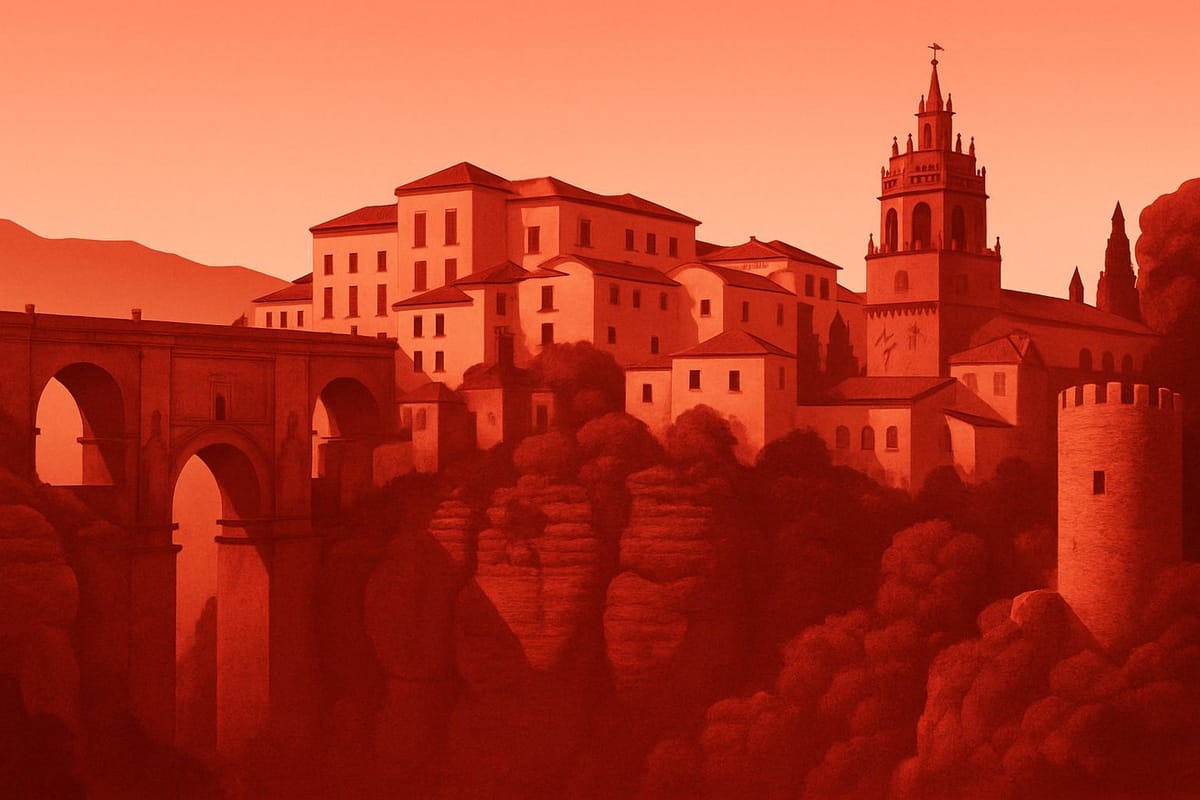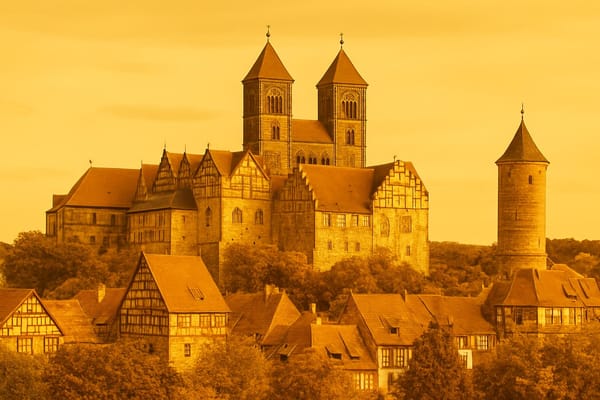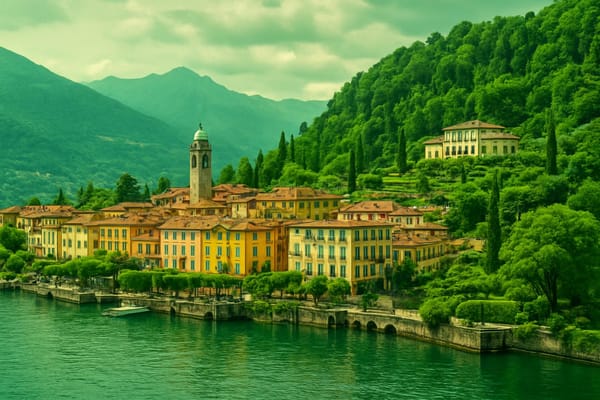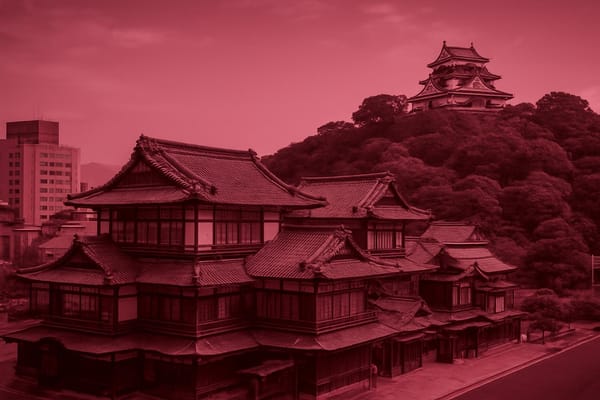Ronda
Iconic cliffside bridge, historic bullring, white-washed alleys and breathtaking gorge views.

Important things to know about Ronda
Ronda, Spain is a captivating Andalusian town perched amid rugged mountains and rolling countryside, where a deep sense of history and living tradition shapes everyday life; its stone streets and whitewashed façades reflect centuries of layered influences that give Ronda a distinctive identity within Málaga province and the wider region of Andalusia, and the city’s climate, rural economy, and cultural rhythms make it an evocative example of southern Spanish living. Local markets, family-run taverns, and artisan workshops sustain a community where gastronomy and seasonal produce are central, and residents balance modern comforts with pride in local crafts, agricultural roots, and centuries-old customs. The urban fabric of Ronda mixes narrow lanes, plazas, and residential neighborhoods that reveal varied architectural details, from humble village houses to more ornate historic buildings, creating an engaging environment for daily life and community gatherings. Festivals, music, and culinary traditions punctuate the calendar, while small businesses, hospitality services, and rural tourism play important roles in the local economy without overwhelming the town’s authentic character. Surrounded by natural landscapes that influence leisure, farming, and outdoor pursuits, Ronda offers a tranquil pace compared with larger Andalusian cities, attracting visitors interested in immersion in culture, landscape, and genuine local rhythms rather than only landmarks, and its enduring charm lies in the harmonious interplay of place, people, and tradition that defines Ronda, Spain.
Sightseeing hot-spots in Ronda
Ronda, Spain overflows with sightseeing highlights that make it one of Andalusia’s most atmospheric towns. Perched dramatically above the gorge, the town is best known for the iconic Puente Nuevo, a stone bridge spanning the dramatic El Tajo Gorge and offering spectacular views of the surrounding countryside. Wandering the cobbled streets of the Old Town (La Ciudad), visitors discover whitewashed houses, charming plazas, and viewpoints perfect for photography, making Ronda a top stop for those searching for Ronda Spain attractions and memorable panoramas.
History and culture converge at the Plaza de Toros de Ronda, one of the oldest bullrings in Spain, where the tradition of bullfighting and its legends are preserved in the museum and arena. Close by, the Palacio de Mondragón and the Casa del Rey Moro reveal Moorish and Renaissance influences with beautiful gardens and historic interiors, while the Baños Árabes (Arab baths) offer a tangible link to the town’s medieval past. These sites together form the core of what to see in Ronda for travelers interested in architecture, history, and authentic Andalusian charm.
Beyond monuments, Ronda’s natural setting draws hikers and daytrippers who want to explore the surrounding Serranía de Ronda mountains and the scenic routes along the gorge. Stroll the leafy Alameda del Tajo for relaxed views, sample local cuisine in quaint taverns, and enjoy sunsets that paint the cliffs golden. Whether you’re planning a weekend escape or a longer Andalusia itinerary, the sightseeing highlights of Ronda promise a blend of dramatic landscapes, rich history, and a timeless Spanish atmosphere.
Hotels to enjoy in Ronda
Ronda, Spain, is a dream destination for travelers seeking dramatic scenery and authentic Andalusian charm, and selecting the right hotels in Ronda can transform a visit into an unforgettable experience. Many visitors prioritize accommodations with clifftop views of the famous Puente Nuevo spanning the Tajo Gorge, while others prefer a quiet stay in the historic center surrounded by cobbled streets, tapas bars, and flamenco. From luxury boutique hotels housed in restored palacios to budget-friendly guesthouses and rural cortijos in the nearby countryside, Ronda offers a broad range of options for couples, families, and solo explorers. Choosing a hotel with a rooftop terrace or panoramic windows enhances your chance to capture sunrise and sunset photos that highlight the town’s whitewashed facades and dramatic cliffs, which is precisely why many travelers search for “best hotels in Ronda” and “Ronda hotels with views.”
Accommodation in Ronda also caters to practical needs: proximity to landmarks, free parking for road-trippers, and easy access to hiking routes in the nearby Sierra de Grazalema and white villages. For a memorable stay, consider hotels that combine historic architecture with modern comforts such as air conditioning, free Wi-Fi, and concierge services offering local tours and wine-tasting experiences. Reviews often mention friendly staff, cleanliness, and the quality of breakfast-details that matter for anyone planning to book hotels in Ronda. Whether you’re aiming for a romantic getaway, a cultural weekend, or a base for exploring Andalusia, selecting the right accommodation in Ronda, Spain, helps ensure your trip is both relaxing and authentic.
Restaurants to try in Ronda
Ronda is a jewel of Andalusia where the restaurants of Ronda, Spain blend dramatic scenery with authentic gastronomy. In the historic center, narrow streets lead to intimate taverns offering a parade of tapas, hearty stews and plates that showcase local olive oil, Iberian ham and seasonal produce from surrounding Serranía de Ronda. Many eateries capitalize on the town’s spectacular setting by serving meals with views of the Puente Nuevo and the vertical walls of El Tajo gorge, creating a dining experience where the location is as memorable as the food. Visitors searching for Ronda restaurants will find a range from cozy family-run bodegas to refined kitchens that reinterpret traditional Andalusian recipes, highlighting ingredients such as fresh tomatoes, smoked paprika and locally produced cheeses.
Dining in Ronda means appreciating both flavor and atmosphere: a leisurely lunch with a menu del día, an evening of shared tapas with a glass of local wine, or a sunset meal on a terrace overlooking historic landmarks. The culinary scene supports sustainable and seasonal cooking, and many chefs draw on centuries-old techniques while embracing modern presentation. For travelers optimizing their search for the best restaurants in Ronda, think about neighborhoods near the bridge for views, the old town for classic ambience, and quieter lanes for authentic, off-the-beaten-path flavors. Whether you seek rustic comfort food or elevated Andalusian cuisine, the restaurants of Ronda, Spain deliver a memorable mix of tradition, taste and spectacular panoramas.
Best shopping stops in Ronda
Ronda’s historic center is a shopper’s delight where shopping in Ronda blends traditional craft with contemporary style. Wandering the cobbled streets around the Puente Nuevo, visitors find charming boutiques that showcase handmade leather goods, bespoke jewelry, and delicate ceramics made by local artisans. The town’s small shops emphasize quality and story, from family-run ateliers producing heirloom leather bags to galleries selling limited-edition prints of Ronda’s dramatic gorge. For those seeking authentic souvenirs, markets and independent stores offer locally produced olive oil, artisan cheeses, and jars of spicy pimentón-perfect mementos of a trip to Ronda, Spain. Photography-friendly storefronts and friendly shopkeepers make every purchase feel like part of the travel experience.
Beyond typical mementos, Ronda’s shopping highlights include specialty food shops and wine cellars stocking local wines and sherries from the surrounding Andalusian vineyards. Fashion-forward travelers will appreciate boutiques that combine modern Spanish trends with classic Andalusian flair, including pieces inspired by flamenco culture and the region’s equestrian tradition. Seasonal markets and weekend fairs add further variety, often featuring live demonstrations by craftsmen and tasting tables where visitors can sample tapas alongside handmade products. Whether hunting for gourmet gifts, collectible ceramics, or stylish clothing, shopping in Ronda provides a memorable blend of cultural discovery and high-quality treasures that reflect the unique spirit of this iconic Spanish town.
Nightlife highlights in Ronda
Ronda’s evenings come alive as the sun sets over the gorge, turning the stone of the Puente Nuevo and the surrounding cliffs a warm gold and drawing both locals and visitors into the heart of the historic center. The best of Ronda nightlife is a relaxed mix of tapas culture and scenic terraces where you can sip local wines while watching the lights reflect on the Guadalevín river. Narrow cobbled streets lead to intimate bars and family-run taverns offering traditional Andalusian dishes, while the plaza cafes buzz with conversation late into the night. For those seeking culture, occasional flamenco evenings and guitar-led acoustic sets capture the region’s soul, giving a memorable soundtrack to any night out in Ronda, Spain.
As darkness deepens, the town shifts from a sightseeing atmosphere to a more convivial, social vibe where night walks across the gorge and visits to rooftop bars reveal panoramic views that are unmistakably Ronda. The nightlife in Ronda may be quieter than larger cities, but it is rich in character: cozy wine bars, hidden courtyards, and friendly local spots where you can find live music or a spontaneous gathering. Weekends bring livelier crowds and occasional late-night festivals, making it a great destination for those who appreciate authentic Spanish evenings, quality tapas bars, and genuine Andalusian hospitality.
Getting around in Ronda
Ronda is a jewel of Andalusia but does not have its own airport, so most visitors reach the city via nearby hubs: the nearest major airport is Málaga‑Costa del Sol (AGP), roughly 100 km away, while Seville and even Gibraltar airports are alternatives for some travelers; expect about 1.5–2.5 hours by car or bus depending on traffic and route. For rail travel, Ronda’s train station is served by Renfe regional services rather than high‑speed AVE trains, offering regular Media Distancia connections to Málaga and onward links toward Antequera/Seville, with typical journey times of around 2 hours to Málaga and 2–3 hours to Seville depending on the service and transfers; trains provide a relaxed, scenic way to approach the town across the Serranía de Ronda. Many visitors combine a flight into Málaga with a direct bus or hire car transfer for greater flexibility, taking advantage of frequent coach services and local taxis; roads are winding but spectacular, so whether you prefer train convenience, airport accessibility, or the freedom of a rental car, planning ahead ensures smooth connections to and from Ronda.
Culture must-see's in Ronda
Ronda, Spain is a jewel of Andalusia whose culture highlights combine dramatic historic architecture, lively traditions and a setting that has inspired writers and artists for centuries. Perched above the spectacular El Tajo gorge, the town’s most iconic sight is the Puente Nuevo, a stone bridge that offers breathtaking views and anchors the old quarter’s evocative atmosphere. Strolling Ronda’s winding cobblestone streets, visitors encounter whitewashed houses, hidden courtyards, and remnants of Moorish influence such as the Arab baths (Baños Árabes), all of which contribute to a powerful sense of layered history. The cultural fabric extends to the legendary Plaza de Toros, one of Spain’s oldest bullrings, where the traditions of bullfighting and the Romero school of horsemanship have shaped local identity and draw interest from those studying Spanish ritual and spectacle. Literary connections-most notably Ernest Hemingway and Orson Welles-have further elevated Ronda’s reputation as a must-see cultural destination in Ronda, Spain tourism guides.
Beyond monumental sites, Ronda’s living culture thrives in its food, music and festivals. The town’s tapas bars and family-run bodegas celebrate Andalusian gastronomy, pairing regional wines with plates of Iberian ham, manchego, and olive oils from nearby groves. Nights come alive with flamenco rhythms and impromptu guitar in cozy plazas, while annual events such as the Feria de Pedro Romero revive equestrian pageantry and local folklore. For those interested in history and quirky local lore, museums including the Museo del Bandolero and small archaeological exhibits reveal stories of banditry, trade and conquest that shaped Ronda’s character. Nature lovers also find cultural resonance in the surrounding Serranía de Ronda landscapes-hiking and vineyard tours offer a way to experience how terroir and tradition combine. Together, these elements make Ronda a compact but rich cultural destination, ideal for travelers seeking the essence of Andalusian culture and the historic charm of Ronda, Spain.
History of Ronda
Ronda’s long and layered history makes the city one of the most fascinating destinations in Andalusia and a jewel in the story of the history of Ronda, Spain. Perched on a dramatic limestone plateau split by the sheer Tajo Gorge, Ronda has archaeological roots stretching back to prehistoric settlements and the Roman outpost near Acinipo. Over centuries the town evolved through a tapestry of influences: the Moorish period introduced remarkable architecture, urban layout and irrigation that shaped the old quarter, while the Reconquista in the late 15th century integrated Ronda into Christian kingdoms and changed social and political life. The dramatic construction of the Puente Nuevo in the 18th century, completed in 1793, became an iconic symbol bridging halves of the town across the Tajo and reflecting an era of ambitious engineering. The city’s proximity to fertile plains and trade routes meant that Ronda was a strategic and cultural crossroads, a place where Roman roads, Islamic baths, and Christian churches layered over one another to create the distinct urban mosaic visitors admire today.
The cultural legacy of Ronda, Spain extends beyond its cliffs; the town is also celebrated for its contribution to Spanish cultural traditions and tourism. The Plaza de Toros, one of the oldest bullrings in the country dating from the late 18th century, anchored Ronda as a center for refined bullfighting traditions and contributed to the creation of literary and artistic myths about Andalusia. In the 19th and 20th centuries Ronda attracted Romantic travelers, writers and artists who were captivated by the dramatic landscape, traditional pueblo blanco charm and stories of rural banditry that once punctuated the countryside. Today the history of Ronda is visible in its narrow cobbled streets, vantage points overlooking the gorge, and preserved monuments that make it a top choice for travelers seeking history, architecture and authentic Andalusian atmosphere. Whether exploring the Moorish quarter, admiring the engineering of the Puente Nuevo, or learning about local customs in museums and plazas, visitors encounter a rich tapestry of events and influences that define Ronda’s enduring historical significance.



